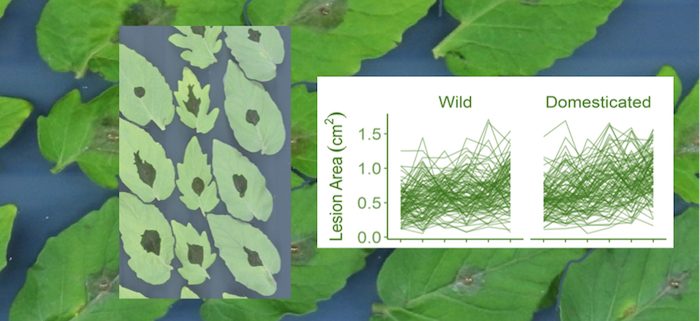Tomato vs. the generalist pathogen Botrytis cinerea
Soltis et al. explore the genetic interactions of the gray mold, Botrytis cinerea, with wild and domesticated tomato. Plant Cell https://doi.org/10.1105/tpc.18.00857
By Nicole E. Soltis and Daniel J. Kliebenstein, Plant Biology Graduate Group and Department of Plant Sciences, University of California, Davis, CA.
Background: The plant-pathology research community has a good understanding of how plant interactions with specialist pathogens (those that can infect only one or a few plant hosts) evolve. This includes the general understanding that these interactions are dominated by variation in large-effect plant resistance and pathogen virulence genes. Furthermore, selection during crop domestication has greatly reduced the plant’s genetic ability to resist these specialist pathogens. By contrast, there are a significant number of generalist plant pathogens such as Botrytis cinerea that can infect an immense number of host plants from moss to pine trees to tomato. Do plant–generalist interactions evolve similarly to those with specialists or are they following a very different path? Answering this question is critical to understanding how plant disease resistance is constructed to handle an environment with both specialist and generalist attackers.
Question: To begin answering these questions, we set about measuring the genetic architecture of natural genetic variation in the plant host, tomato, and the generalist pathogen, Botrytis cinerea. By using both wild and domestic tomato genotypes, we could test if domestication influenced the answers obtained.
Findings: Analysis of a collection of 12 tomato genotypes and 97 Botrytis cinerea isolates showed that there was extensive genetic variation in both organisms influencing the interaction. The pathogen’s virulence variation showed no evidence of large effect loci and was instead linked to hundreds of potential causal genes of modest to small effect. Unexpectedly, the disease outcome of the interaction was largely independent of the influence of domestication. This suggests that plant–generalist interactions may not follow the large-effect co-evolutionary model that is so successful at explaining plant–specialist interactions. Instead, the interaction is mediated by hundreds of small to modest effect loci in both the plant and the pathogen.
Next steps: Future work is necessary to know if these observations from the interaction of tomato and Botrytis extend to other plant species and crop systems. This will also require developing evolutionary models that attempt to describe potential co-evolutionary relationships that are entirely polygenic.
Nicole E. Soltis, Susanna Atwell, Gongjun Shi, Rachel F Fordyce, Raoni Gwinner, Dihan Gao, Aysha Shafi, Daniel J. Kliebenstein (2019). Interactions of tomato and Botrytis genetic diversity: Parsing the contributions of host differentiation, domestication and pathogen variation. Plant Cell 31: xx; DOI: https://doi.org/10.1105/tpc.18.00857
Key words: Tomato, Botrytis, Domestication, GWA.




